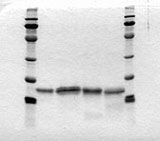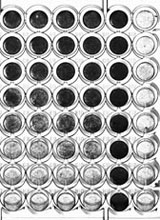[1] Sergey E. Perchenov et al. (2002) Mutant analogues of human interferongamma with higher stability and activity. Protein Expression and Purification 24, 173-180
[2] Kontsek, P.; Waschütza, G.; Kontsekova, E. and Otto, B. (2000) Engineered acidstable human interferon-gamma. Cytokine 12, 708-710
[3] Waschütza, G.; Dengler, U.; Villmann, C.; Böttinger, H. and
Otto, B. (1998) Interferon-g variants with deletions in the AB-surface loop. Eur. J. Biochem. 256, 303-309
[4] Waschütza, G.; Li, V.; Schäfer, T.; Schomburg, D.; Villmann, C.; Zakaria, H. and Otto, B. (1996) Engineered disulfide bonds in recombinant human interferon-γ: The impact of the N-terminal helix A and the AB-loop on protein stability. Protein Engng. 9, 905-912
[5] Slodowski, O.; Bohm J.; Schöne B.; and Otto, B. (1991) Carboxy-terminal truncated rhuIFN-gamma with a substitution of Gln133 or Ser132 to leucine leads to higher biological activity than in the wild type. Eur. J. Biochem. 18, 1133-1140
 Fraunhofer Institute for Interfacial Engineering and Biotechnology IGB
Fraunhofer Institute for Interfacial Engineering and Biotechnology IGB
